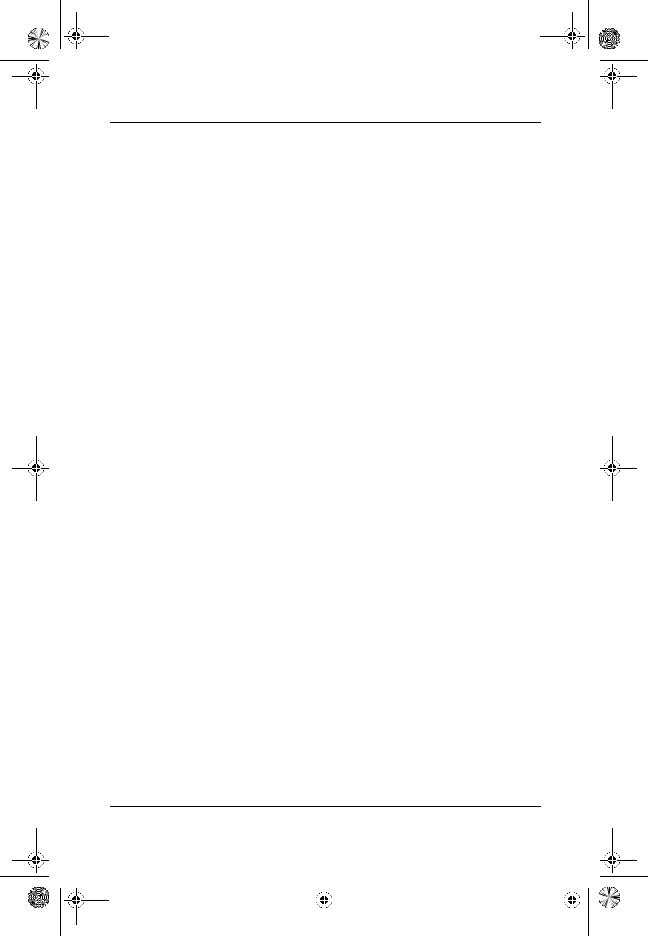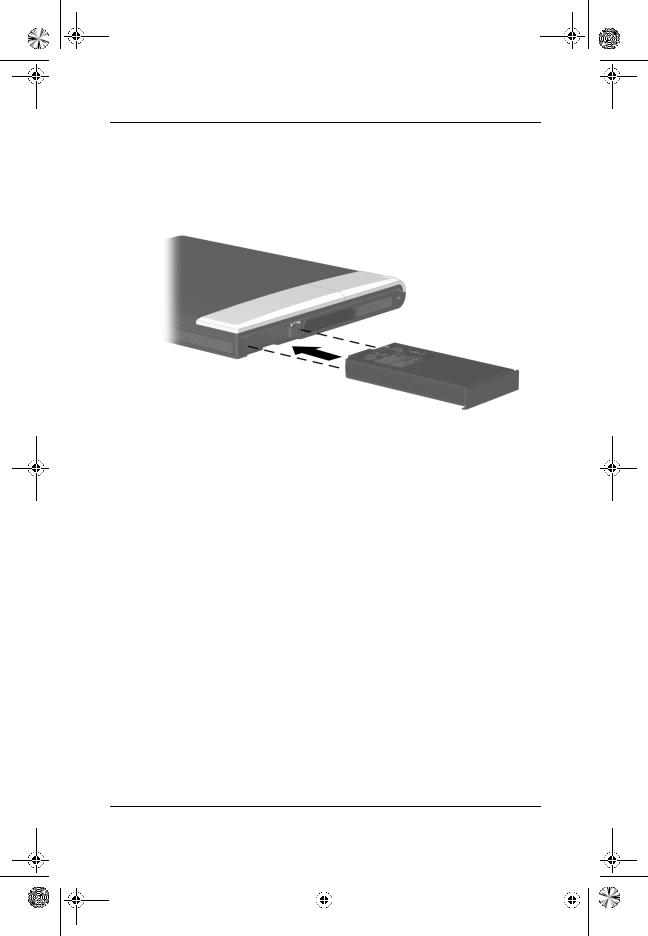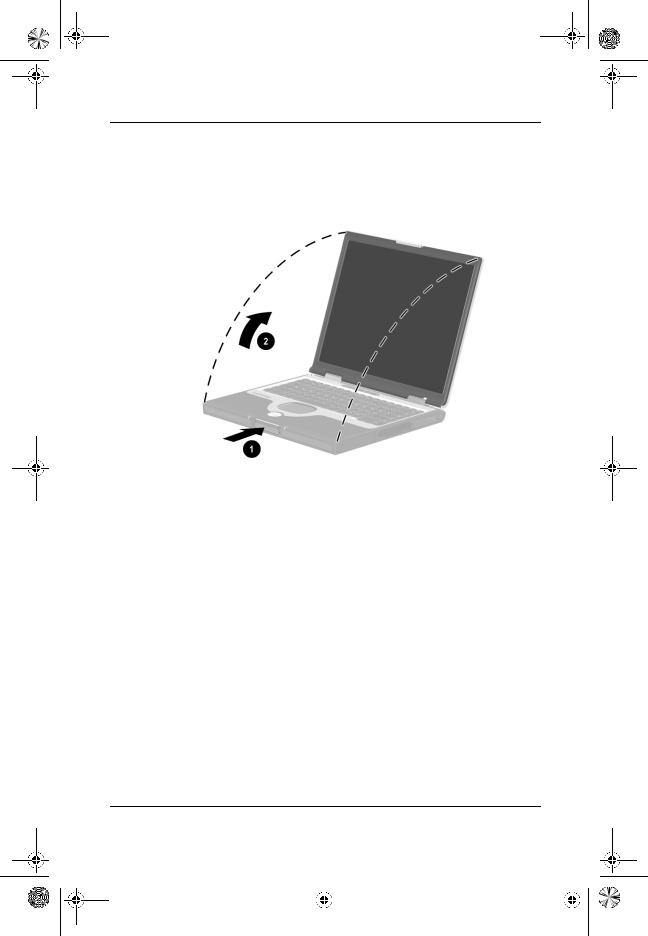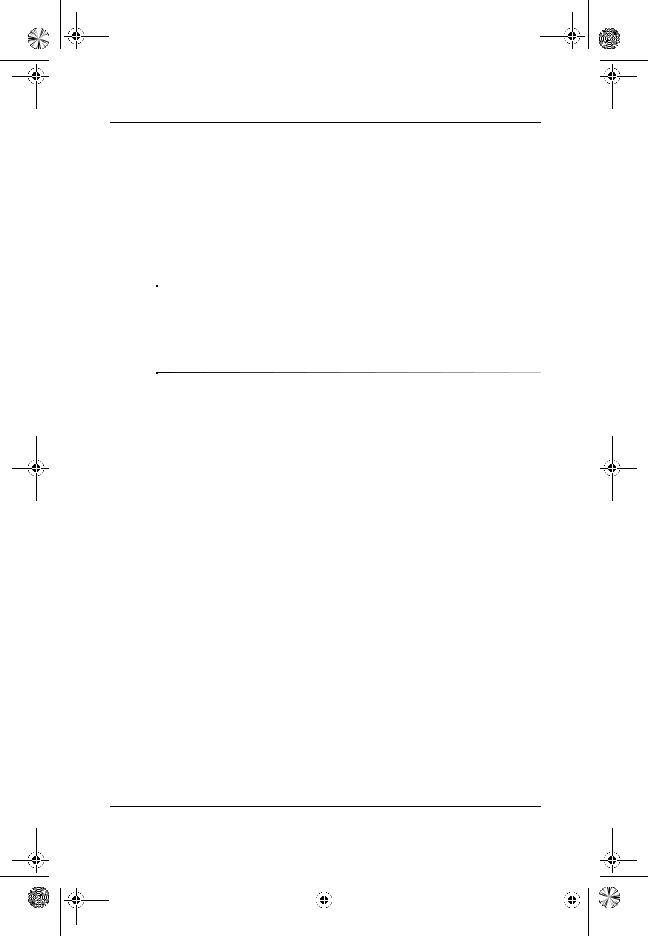HP Compaq Evo n800c, Compaq Presario 2800AP, Compaq Presario 2800AU, Compaq Presario 2800CA, Compaq Presario 2800EA Getting Started Guide
...
266551-003.book Page i Thursday, February 20, 2003 11:33 AM
b
Getting Started
compaq notebook series
Document Part Number: 266551-003
April 2003
This guide explains how to set up your hardware and software, begin using the notebook, troubleshoot problems, and contact Compaq if you need assistance. The last chapter introduces you to the exterior features of the notebook.

266551-003.book Page ii Thursday, February 20, 2003 11:33 AM
© 2003 Hewlett-Packard Development Company, L.P.
Microsoft and Windows are trademarks of Microsoft Corporation in the U.S. and/or other countries. All other product names mentioned herein may be trademarks of their respective companies.
HP shall not be liable for technical or editorial errors or omissions contained herein or for incidental or consequential damages in connection with the furnishing, performance, or use of this material. The information in this document is provided “as is” without warranty of any kind, and is subject to change without notice. The warranties for HP products are set forth in the express limited warranty statements accompanying such products. Nothing herein should be construed as constituting an additional warranty.
Getting Started
Third Edition April 2003
First Edition April 2002
Reference Number: N800/2800
Document Part Number: 266551-003

266551-003.book Page iii Thursday, February 20, 2003 11:33 AM
Using This Guide
This preface explains how to interpret the symbols, text styles, and paths in your notebook documentation.
Warnings, Cautions and Notes
Warnings and cautions contain important information that can protect you, your work, and your system. Always read warnings and cautions.
Notes contain additional information about a topic. Some notes provide basic information for inexperienced users. Others provide technical information for advanced users.
The following icons identify warnings, cautions, and notes.
ÅWARNING: The information in a warning protects against bodily harm or loss of life.
ÄCAUTION: The information in a caution protects against damage to your work, your notebook, or an optional external device.
The information in a note provides supplementary information for inexperienced or advanced users.
Getting Started |
|
|
iii |
||
|
|
|
|
|
|
|
|
|
|
|
|
|
|
|
|
|
|

266551-003.book Page iv Thursday, February 20, 2003 11:33 AM
Using This Guide
Text Styles
Some text in your notebook documentation is styled typographically to help you interpret the information it contains. For example, keyboard keys are styled like this: shift key. Buttons that display on the screen are styled like this: Next button.
The following table identifies and explains the text styles used in your notebook documentation.
Style |
Explanation |
|
|
keys |
Identifies a key, such as the enter key, on the |
|
notebook keyboard or on an optional external |
|
keyboard. |
|
A plus sign (+) between 2 or more keys indicates |
|
that they are a key combination. To use most key |
|
combinations: |
|
■ Briefly press the first key, then briefly press |
|
each succeeding key. |
|
or |
|
■ Press and hold the first key, press and hold |
|
each succeeding key, then release all the keys |
|
simultaneously. |
|
Unless you are instructed to do so, do not press the |
|
keys in a key combination simultaneously. |
|
|
commands |
Identifies characters you are asked to type. For |
|
example, to visit the Compaq Web site, you would |
|
type http://www.compaq.com into the address field |
|
on your Web browser. |
|
|
Initial Capital |
Identifies words that appear on the screen. For |
Letters |
example, in a procedure for displaying an icon on |
|
the taskbar, you might be asked to select a Show |
|
Icon On The Taskbar check box. |
|
|
iv |
|
|
Getting Started |
||
|
|
|
|
|
|
|
|
|
|
|
|
|
|
|
|
|
|

266551-003.book Page v Thursday, February 20, 2003 11:33 AM
Using This Guide
Paths
Following a Path
Many instructions in documentation direct you to locations within the operating system, an application, or a utility where you can select settings. The greater than symbol (>) is used to direct you from destination to destination along the path to the settings.
As you follow paths, do nothing at each destination along the way except select the next destination. The paths in your notebook documentation:
Explain whether to look for an icon, a tab, or a button on the screen. Tabs are displayed along the top edge of individual windows.
Are based on the notebook pointing device functions set at the factory:
To select, press the left TouchPad button 1 once.
To double-click, press the left TouchPad button twice.
To right-click, press the right TouchPad button 2 once.
Most paths to Windows destinations begin with “Start >.” To select Start (and display the Windows Start menu), select the Start button in the lower left corner of your screen or press either of the Microsoft logo keys 3 on the keyboard.
Identifying TouchPad buttons and the Microsoft logo keys
Getting Started |
|
|
v |
||
|
|
|
|
|
|
|
|
|
|
|
|
|
|
|
|
|
|

266551-003.book Page vi Thursday, February 20, 2003 11:33 AM
Using This Guide
Choosing a Path
Your notebook documentation provides paths for 3 operating systems.
Follow the Windows 2000 Professional paths if:
The notebook is running Windows 2000 Professional. or
The notebook is running Windows XP Home or Windows XP Professional in Classic view.
Follow the Windows XP Home or Windows XP Professional paths if the notebook is running Windows XP Home or Windows XP Professional in Category view.
As installed, Windows XP Home and Windows XP Professional run in Category view. To compare Category view with Classic view or to select either view:
1.Right-click the Start button > Properties > Start Menu tab.
2.Select the Classic or Category radio button. (The views are displayed in the illustration on the Start Menu tab.)
3.Follow the instructions on the screen.
vi |
|
|
Getting Started |
||
|
|
|
|
|
|
|
|
|
|
|
|
|
|
|
|
|
|

266551-003.book Page vii Thursday, February 20, 2003 11:33 AM
Contents
Using This Guide
1 Setting Up the Notebook
Setting Up the Hardware . . . . . . . . . . . . . . . . . . . . . . . . . 1–1 Inserting the Battery Pack . . . . . . . . . . . . . . . . . . . . . 1–2 Connecting the Notebook to External Power . . . . . . 1–3 Opening the Notebook. . . . . . . . . . . . . . . . . . . . . . . . 1–4 Turning On the Notebook . . . . . . . . . . . . . . . . . . . . . 1–5
Setting Up the Software . . . . . . . . . . . . . . . . . . . . . . . . . . 1–6 Turning Off the Notebook . . . . . . . . . . . . . . . . . . . . . . . . 1–7 Using the Notebook Safely . . . . . . . . . . . . . . . . . . . . . . . 1–7
2 Beginning to Use the Notebook
Selecting Regional Settings . . . . . . . . . . . . . . . . . . . . . . . 2–1 Selecting Screen Settings . . . . . . . . . . . . . . . . . . . . . . . . . 2–1 Protecting the Notebook Against Viruses . . . . . . . . . . . . 2–2 Installing Optional Software . . . . . . . . . . . . . . . . . . . . . . 2–3 Accessing Notebook Documentation. . . . . . . . . . . . . . . . 2–5
Inserting a CD Drive or a DVD Drive. . . . . . . . . . . . 2–5 Inserting the Documentation Library CD . . . . . . . . . 2–6 Opening the Documentation Library CD . . . . . . . . . 2–7 Using the Documentation Library CD . . . . . . . . . . . . . . . 2–8 Selecting a Guide. . . . . . . . . . . . . . . . . . . . . . . . . . . . 2–8 Finding a Topic Within a Guide . . . . . . . . . . . . . . . . 2–9
Getting Started |
|
|
vii |
||
|
|
|
|
|
|
|
|
|
|
|
|
|
|
|
|
|
|

266551-003.book Page viii Thursday, February 20, 2003 11:33 AM
Contents
3 Troubleshooting
Quick Solutions Checklist . . . . . . . . . . . . . . . . . . . . . . . . 3–2 Is the Notebook Receiving Power? . . . . . . . . . . . . . . 3–2 Is the Notebook Turned On? . . . . . . . . . . . . . . . . . . . 3–3 Is the Notebook in Standby or Hibernation? . . . . . . . 3–3 Is the Notebook Overheated? . . . . . . . . . . . . . . . . . . 3–4 Is the System Unresponsive?. . . . . . . . . . . . . . . . . . . 3–4 Is an External Device Not Working?. . . . . . . . . . . . . 3–5 Are You Using All Available Documentation?. . . . . 3–5 Is Software Functioning Abnormally? . . . . . . . . . . . 3–6
Contacting Compaq . . . . . . . . . . . . . . . . . . . . . . . . . . . . . 3–7 Preparing to Call Technical Support . . . . . . . . . . . . . 3–7 Taking the Notebook to a Service Provider. . . . . . . . 3–8
4 Identifying Exterior Hardware
Display Components . . . . . . . . . . . . . . . . . . . . . . . . . . . . 4–1
Pointing Device Components. . . . . . . . . . . . . . . . . . . . . . 4–2
TouchPad Models . . . . . . . . . . . . . . . . . . . . . . . . . . . 4–2
Dual Device Models . . . . . . . . . . . . . . . . . . . . . . . . . 4–3
Top Components . . . . . . . . . . . . . . . . . . . . . . . . . . . . . . . 4–4
Power Lights . . . . . . . . . . . . . . . . . . . . . . . . . . . . . . . 4–4
Keyboard and Drive Lights . . . . . . . . . . . . . . . . . . . . 4–5
Power and Volume Controls . . . . . . . . . . . . . . . . . . . 4–6
Easy Access Buttons and Keyboard Keys. . . . . . . . . 4–7
Function and Keypad Keys . . . . . . . . . . . . . . . . . . . . 4–8
Front Panel Components . . . . . . . . . . . . . . . . . . . . . . . . . 4–9
Rear Panel Components . . . . . . . . . . . . . . . . . . . . . . . . . 4–10
Connectors . . . . . . . . . . . . . . . . . . . . . . . . . . . . . . . . 4–10
Vent, Port and Jacks . . . . . . . . . . . . . . . . . . . . . . . . 4–11
Left Side Components . . . . . . . . . . . . . . . . . . . . . . . . . . 4–12
Right Side Components . . . . . . . . . . . . . . . . . . . . . . . . . 4–13
viii |
|
|
Getting Started |
||
|
|
|
|
|
|
|
|
|
|
|
|
|
|
|
|
|
|

266551-003.book Page ix Thursday, February 20, 2003 11:33 AM
Contents
Underside Components . . . . . . . . . . . . . . . . . . . . . . . . . 4–14
Memory and Mini PCI Compartments . . . . . . . . . . 4–14
Bay Components . . . . . . . . . . . . . . . . . . . . . . . . . . . 4–15
Vent and Docking Components. . . . . . . . . . . . . . . . 4–16
Labels. . . . . . . . . . . . . . . . . . . . . . . . . . . . . . . . . . . . 4–17
Additional Standard Components . . . . . . . . . . . . . . . . . 4–18
Documentation and Restore CDs . . . . . . . . . . . . . . 4–18
Cord and Cables. . . . . . . . . . . . . . . . . . . . . . . . . . . . 4–19
Adapters and Accessories . . . . . . . . . . . . . . . . . . . . 4–20
Index
Getting Started |
|
|
ix |
||
|
|
|
|
|
|
|
|
|
|
|
|
|
|
|
|
|
|

266551-003.book Page x Thursday, February 20, 2003 11:33 AM
Contents
x |
|
|
Getting Started |
||
|
|
|
|
|
|
|
|
|
|
|
|
|
|
|
|
|
|

266551-003.book Page 1 Thursday, February 20, 2003 11:33 AM
1
Setting Up the Notebook
Setting Up the Hardware
To set up the notebook for the first time, you will need the notebook, the battery pack 1, the AC Adapter 2, and the power cord 3.
Identifying the battery pack, the AC Adapter, and the power cord (AC Adapters and power cords vary by region.)
Getting Started |
|
|
1–1 |
|
|
|
|
|
|
|
|
|
|
|
|

266551-003.book Page 2 Thursday, February 20, 2003 11:33 AM
Setting Up the Notebook
Inserting the Battery Pack
To insert the battery pack, slide the battery pack into the battery bay until it clicks into place.
Inserting the battery pack
1–2 |
|
|
Getting Started |
||
|
|
|
|
|
|
|
|
|
|
|
|
|
|
|
|
|
|

266551-003.book Page 3 Thursday, February 20, 2003 11:33 AM
Setting Up the Notebook
Connecting the Notebook to External Power
ÄCAUTION: To prevent file corruption and be sure that the correct drivers load, do not turn on the notebook for the first time while it is docked in an optional port replicator.
To connect the notebook to external power:
1.Place the notebook on a flat surface near an electrical outlet.
2.Plug the AC Adapter cable into the DC power connector 1.
1.Plug the power cord into the AC Adapter 2 and into an accessible electrical outlet 3.
When the notebook receives AC power, the AC Adapter light 4 turns on.
Connecting the notebook to external power
(AC Adapters, power cords, and electrical outlets vary by region.)
Getting Started |
|
|
1–3 |
|
|
|
|
|
|
|
|
|
|
|
|

266551-003.book Page 4 Thursday, February 20, 2003 11:33 AM
Setting Up the Notebook
Opening the Notebook
To open the notebook, briefly press the display release latch 1 as you raise the display 2.
Opening the notebook
1–4 |
|
|
Getting Started |
||
|
|
|
|
|
|
|
|
|
|
|
|
|
|
|
|
|
|

266551-003.book Page 5 Thursday, February 20, 2003 11:33 AM
Setting Up the Notebook
Turning On the Notebook
To turn on the notebook, briefly press the power button 1. When the notebook is on, the power/standby light 2 turns on, and you are prompted to begin software setup.
If the notebook does not turn on, refer in this guide to Chapter 3.
Turning on the notebook
Getting Started |
|
|
1–5 |
|
|
|
|
|
|
|
|
|
|
|
|

266551-003.book Page 6 Thursday, February 20, 2003 11:33 AM
Setting Up the Notebook
Setting Up the Software
A prompt to set up your software is displayed on the screen when the notebook is turned on for the first time.
Before responding to the prompt and proceeding through the online instructions, read the following caution and other installation information.
ÄCAUTION: To prevent file corruption and be sure that the correct device drivers install, during software setup:
■Do not unplug the notebook from the electrical outlet.
■Do not shut down the notebook.
■Do not remove or insert a drive.
■Once you begin the software setup, you must complete the
entire process without interruption. Setup time varies.
■If you are prompted to select a language, choose carefully. The languages that you do not choose are deleted from the system and cannot be restored during the installation.
■When you are prompted to accept the End User License Agreement, you must choose Accept to continue the software setup.
1–6 |
|
|
Getting Started |
||
|
|
|
|
|
|
|
|
|
|
|
|
|
|
|
|
|
|

266551-003.book Page 7 Thursday, February 20, 2003 11:33 AM
Setting Up the Notebook
Turning Off the Notebook
Whenever possible, shut down the notebook by following the Windows shut down procedure provided below for your operating system. For information about using these procedures, refer in this guide to “Using This Guide,” “Paths.”
To shut down the notebook using a Windows shut down procedure:
■In Windows 2000 Professional:
1.Select Start > Shut Down.
2.Select and hold the down arrow beside the What Do You Want the Computer To Do drop-down list until Shut Down is displayed.
3.Select the OK button.
■In Windows XP Home or Windows XP Professional, select Start > Turn Off Computer button > Turn Off button.
If the notebook does not respond to a Windows shut down procedure, refer in this guide to Chapter 3, “Troubleshooting,” “Quick Solutions Checklist” section, “Is the Notebook Unresponsive?”
Using the Notebook Safely
To protect the notebook from the power surges that may be caused by an uncertain power supply or an electrical storm:
■Plug the notebook power cord into an optional, high-quality surge protector.
■Provide surge protection on the cable that connects the modem to the telephone line.
■During an electrical storm, run the notebook on battery power or shut down the notebook and disconnect the power cord.
Getting Started |
|
|
1–7 |
|
|
|
|
|
|
|
|
|
|
|
|

266551-003.book Page 8 Thursday, February 20, 2003 11:33 AM
Setting Up the Notebook
Surge protectors are available from most computer or electronics retailers.
To learn more about protecting yourself, your work, and your notebook from electrical and other risks, read the following warnings:
ÅWARNING: The notebook is designed to run demanding applications at full power. As a result of increased power consumption, it is normal for the notebook to feel warm or hot when used continuously. To avoid potential discomfort or burns, do not block the air vents or use the notebook on your lap for extended periods. The notebook complies with the user-accessible surface temperature limits defined by the international Standard for Safety of Information Technology Equipment (ICE 60950).
This equipment has been tested and found to comply with the limits for a Class B digital device, pursuant to part 15 of the FCC Rules.
ÅWARNING: To reduce the risk of electric shock or damage to your equipment:
■Plug the power cord into an electrical outlet that is easily accessible at all times.
■Disconnect power from the product by unplugging the power cord from the electrical outlet.
■If provided with a three-wire power supply cord having a three-pin attachment plug, plug the cord into a grounded (earthed) outlet. Do not disable the power cord grounding pin. The grounding pin is an important safety feature.
ÅWARNING: To reduce the risk of serious injury, read the Safety & Comfort Guide. It describes proper workstation setup, posture, and health and work habits for computer users, and provides important electrical and mechanical safety information. This guide is located on the Web at <<www.compaq.com/ergo>> and on the hard drive or
on the Documentation Library CD that is included with the product.
1–8 |
|
|
Getting Started |
||
|
|
|
|
|
|
|
|
|
|
|
|
|
|
|
|
|
|

266551-003.book Page 1 Thursday, February 20, 2003 11:33 AM
2
Beginning to Use the Notebook
Selecting Regional Settings
Keyboard language and other regional preferences, such as time, date, and currency format, are set in the operating system.
To access regional settings:
■In Windows 2000 Professional, select Start > Settings > Control Panel > Regional Options.
■In Windows XP Home or Windows XP Professional, select Start > Control Panel > Date, Time, Language and Regional Options.
For information about selecting regional settings, open the Regional Options window, then use context-sensitive Help. To use context-sensitive Help, select the question mark button in the upper right corner of the window, then select an item. A definition, explanation, or procedure is displayed.
Selecting Screen Settings
If you would like to see more items on your screen or to see the items on your screen displayed larger, change the screen resolution setting in your operating system.
Getting Started |
|
|
2–1 |
|
|
|
|
|
|
|
|
|
|
|
|

266551-003.book Page 2 Thursday, February 20, 2003 11:33 AM
Beginning to Use the Notebook
To access the screen resolution setting:
■In Windows 2000 Professional, select Start > Settings > Control Panel > Display > Settings tab.
■In Windows XP Home or Windows XP Professional, select Start > Control Panel > Appearance and Themes icon > Change The Screen Resolution task > Settings tab.
To change the screen resolution setting, which is called the screen area setting in Windows 2000 Professional:
1.Press and hold down the left TouchPad button as you move the slider on the Settings tab. The image on the monitor illustrated above the slide bar changes as you move the slide bar.
2.When the image on the illustrated monitor is the image you would like to use on the notebook, select the OK button, then follow the instructions on the screen.
For information about setting other screen preferences in the Display Properties window, use context-sensitive Help. To use context-sensitive Help, select the question mark button in the upper right corner of the window, then select an item. A definition, explanation, or procedure is displayed.
Protecting the Notebook Against Viruses
When you use the notebook for email, network, or Internet access, you expose the notebook to computer viruses. Computer viruses can disable the operating system, your applications, or your utilities or cause them to function abnormally.
Antivirus software can detect most viruses, destroy them, and, in most cases, repair any damage they have caused.
Compaq strongly recommends that you install optional antivirus software before using your modem or a network connection. Antivirus software is available from most computer or electronics retailers.
2–2 |
|
|
Getting Started |
||
|
|
|
|
|
|
|
|
|
|
|
|
|
|
|
|
|
|
